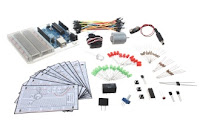I've been crazy busy with our start-up for the last week or so, but I've still managed to find time to look at Seeed Studio's Grove Toy Kit . The kit consists of an Arduino shield (the Twig ), a set of peripherals (the Leaves ), and a set of cables that you use to link them up. OLED display The Leaves in the Toy Kit include a couple of high-powered servos, a tri-colour LED, a tiny, crisp 128*64 OLED display, a sound sensor, a buzzer, a PIR motion sensor, a 3-axis accelerometer and plenty of cables. There are many other leaves available, and they can all connected to the motherboard using the cables provided. The documentation is sparse, but usable; we'll do our best to add to it. At present the Grove is targeted at the Arduino, but we're looking at the possibility of connecting it to the Raspberry Pi. It's a natural fit with our planned extension board, and would offer an excellent platform for experimenters wanting to explore the Internet of ...










